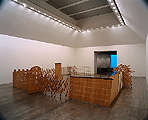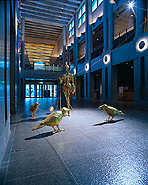
|
|
Apr. 15, 1997 (a)
|
Column Index - Apr. 8, 1997
![]()

<<Art Scene 90-96>>
Yasumasa MORIMURA
Asako TOKITSU
Hidetoshi NAGASAWA
Ryoichi MAJIMA
Tetsuya NAKAMURA
All photo is installation at the Art Tower Mito
Yasumasa MORIMURA
Profile: Yasumasa Morimura
Yasumasa Morimura - Reference Page
GO ON THE STAGE MORIMURA
Morimura Yasumasa 1985-1996
Yutaka SONE - Scoop (in Japanese)
Welcome to the Daimler-Benz Home Page
Kazuhiko HACHIYA's One Week at the Ars Electronica
PostPet (Kazuhiko HACHIYA)
<<NO FUTURE>> by Makoto AIDA
Temple Bar Virtual Gallery (Mapplethorpe)
Robert Mapplethorpe - Reference Page
FINE Magazine Photography: Barbara Kasten
TAMA VIVANT '85 / Noe AOKI
Studio Shokudo - Tetsuya NAKAMURA
Kyo No Machiya / Entrance
Christo & Jeanne-Claude Home Page
Christo and MPEG
Tadashi KAWAMATA "Coal Mine Project in Kyushu"
Bienal - Universalis - Cai Guo-Qiang
Profile: Cai Guo Qiang
Iwanami Paperback (Yohei NISHIMURA)
|
<<Art Scene 90-96
<<Art Scene 90-96>> was a group exhibition held from last fall until mid March in two phases, at the Contemporary Art Center, Art Tower Mito. Several works each, including those not shown previously, by artists introduced in the exhibitions curated by this center in the early 1990's, were exhibited, and this show could also be considered a retrospective exhibition of the center itself, using the names of the artists. The first phase, titled <<Seeing Is Believing>>, had paintings by 20 artists/groups, and works using photography or video, and in the second phase titled <<Floating Forms>>, there were mainly sculpture and installations by 12 artists. For both the first and second phase, the show was structured by young artists in the forefront of contemporary art in Japan, fully indicating the achievements of the center, which opened in 1990, as a revolutionary space specializing in the introduction of contemporary art. However, the content of the exhibition not necessarily proved the rich results of fine art in the past several years. First phase The exhibition site for the first phase was a large exhibition room, featuring a confrontation between two famous artists, Miran FUKUDA and Yasumasa MORIMURA. The large "painting" drawn with color markers, which are not generally used as tools for fine art, and her "work" imitating the landscape paintings painted by unknown painters for cheap sale, re-questioned the value of fine art. These seemed fresh at the time of first showing, but they were not interesting for more than two viewings. The works by MORIMURA included three works from a photography series where he dressed as famous actresses and posed in a scene from a movie, which were then painted by a movie billboard painter. The "Actress" series had become talked about both in and out of Japan, but it was questionable whether those bore new meaning by having them transferred to paintings. There are quite a few artists who continue to create "related works" after one attempt becomes successful, and this was probably one of those instances. The writer does not accept works using video as "fine art" in the first place, however, in the work where Yutaka SONE connected images taken by several of his acquaintances, which were scenes taken from the window of an overnight bus when they traveled overseas, one could discover a meaning of reconsidering the subjectivity of an "artist", and it was slightly interesting. However, the work by Tatsuo MIYAJIMA, who took a film of himself hanging and counting numbers, could not be taken as more than a self-satisfaction of an artist, no matter how it was explained. Although the work by Tatsuya YUSA, where he featured photographs of scrapping a whale and models of food using whale meat, was interesting as a type of documentary, it did not reach the realm of art. However, Asako TOKITSU's drawing resembling a parabola drawn little by little on the wall facing the window of a narrow and long exhibition room, and her installation consisting of parts taken from each step of the production from the drawing layered with glass panels which were placed on the inside and outside of the window, were impressive with their clever artistry of the space and refreshing visual effect. With the support of the Daimler-Benz Group, Tokitsu was chosen to join the artist-in-residence program for young contemporary artists in Japan, and will be staying in Monflanquin, a small city in the Gascogne region in the southwestern area of France, where she will be producing and showing her works. She is an artist whose future has high expectations. The title of the first phase, <<Seeing Is Believing>>, is the same as the title of the work by Kazuhiko HACHIYA, in which one could read the letters on an electric signboard when he looks through a special box. In a way, if the aim was to select meaningful work in terms of the context of contemporary art continuing to pose the question of "Is seeing believing?", rather than HACHIYA's work which was simply an "instrument" whatever the concept, works by artists such as FUKUDA, MORIMURA or SONE should have been considered. Other participating artists were Takanobu KOBAYASHI, Mika YOSHIZAWA, Yuumi DOMOTO, and Makoto AIDA. Overseas artists included Robert Mapplethorpe and Barbara Kasten. Second phase On the other hand, the title of the second phase, <<Floating Forms>>, was the title of the wooden sculpture shaped like a boat by Susumu KOSHIMIZU. The fulfillment of the work by the veteran artist, KOSHIMIZU, was obvious, but Ryoichi MAJIMA, who reminded us of the fun of plastic art by placing humorous sculptures of crows inside and outside of the site building, and the sculpture by Noe AOKI, in which the complex texture of the burnt cross section, gave the freshness similar to a living organism to an iron form, were especially impressive. Also, the work by Tetsuya NAKAMURA who tends to lean towards works like objects that only have interest on the surface and do not give us any heart-moving impressions, which was a sculpture of a gigantic horse covered with mother-of-pearl work, was an ambitious work carrying multi-layered meanings questioning the boundary between fine art and craft, and artwork and monument, and his work could be highly evaluated. However, Katsushige NAKAHASHI's tea room where the photograph of the top of his own head was used as the wall and which was said to express "emotions", was merely unconventional, and Hiroshi FUJI's dog sculptures placed here and there in the exhibition space, were not interesting at all. The highlight was certainly the installation by Hidetoshi NAGASAWA, who surrounded square spaces using fences of various form, creating poetic and meditational spaces. They were works that were like the black hole, imbibing any kind of words for explanation, and one could only simply express respect. Other works were photographs and drawings introducing the works by Christo & Jeanne-Claude where they covered the Berlin Parliament Building with a gigantic cloth, documentary material for the projects by Tadashi KAWAMATA and Cai Guo Qiang, and sculptures by Kodai NAKAHARA and Yohei NISHIMURA. Expectations for the latter half of the '90's for the "recovery of fine art" Although it was limited to artists "witnessed by the Art Tower Mito", through the first and second phase, we were able to see the recent overview of the works by several artists representing Japanese contemporary art. They were not necessarily new works, so it is difficult to forecast the development of their art in the future. However, in retrospect, whether it be two-dimensional, such as paintings, or sculptures and installations, it was unfortunate that the attitude to pursue the fundamental value of art that "represents the image of a world by an artist strictly through form and through the functions of vision (without borrowing the help of reading comprehension or sound, and time)" was not seen so much, especially among the young artists. I would like to look forward to the "recovery of art" in the time to come. [Satoru NAGOYA/Art Journalist]
|
|
|
|
|
|
|
|
|
Apr. 15, 1997 (a)
|
[home]/[Art information]/[Art Watch]
Copyright (c) Dai Nippon Printing Co., Ltd. 1997
Network Museum & Magazine Project / nmp@nt.cio.dnp.co.jp




